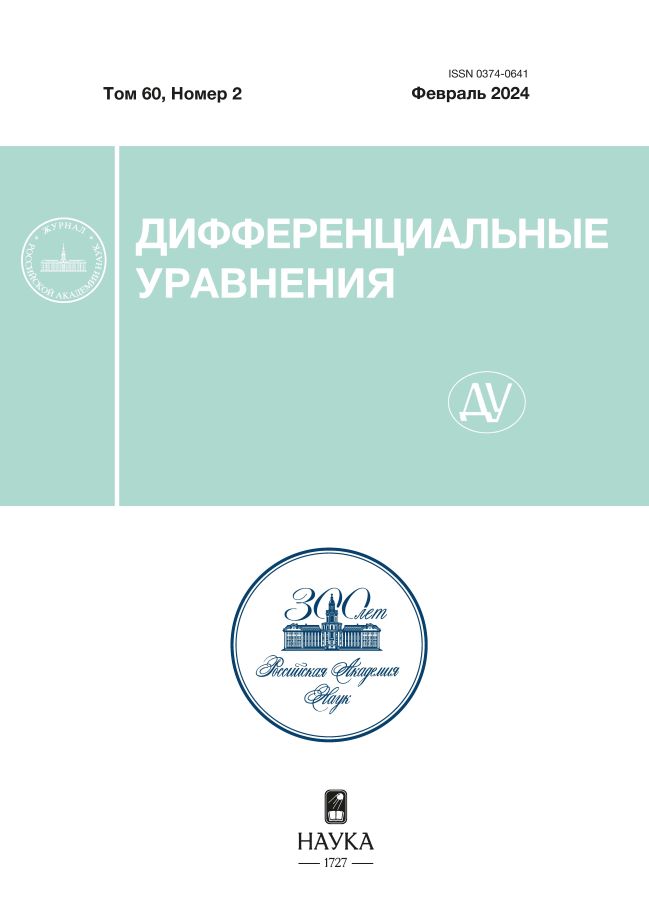Gradient in the problem of controlling processes described by linear pseudohyperbolic equations
- Autores: Romanenkov A.M.1,2
-
Afiliações:
- Moscow Avaition Institute
- Research Center “Informatics and Control” of RAS
- Edição: Volume 60, Nº 2 (2024)
- Páginas: 224-236
- Seção: CONTROL THEORY
- URL: https://kazanmedjournal.ru/0374-0641/article/view/649557
- DOI: https://doi.org/10.31857/S0374064124020068
- EDN: https://elibrary.ru/QKNNLQ
- ID: 649557
Citar
Texto integral
Resumo
The paper considers the problem of controlling processes, the mathematical model of which is an initial-boundary value problem for a pseudohyperbolic linear differential equation of high order in the spatial variable and second order in the time variable. The pseudohyperbolic equation is a generalization of the ordinary hyperbolic equation, which is typical in vibration theory. As examples, models of vibrations of moving elastic materials were considered. For model problems, an energy identity is established, and conditions for the uniqueness of a solution are formulated. As an optimization problem, we considered the problem of controlling the right side in order to minimize the quadratic integral functional, which evaluates the proximity of the solution to the objective function. From the original functional a transition was made to the majorant functional, for which the corresponding upper bound was established. An explicit expression for the gradient of this functional is obtained, and conjugate initial-boundary value problems are derived.
Palavras-chave
Texto integral
Sobre autores
A. Romanenkov
Moscow Avaition Institute; Research Center “Informatics and Control” of RAS
Autor responsável pela correspondência
Email: romanaleks@gmail.com
Rússia, Moscow; Moscow
Bibliografia
- Hyperbolic models arising in the theory of longitudinal vibration of elastic bars / I. Fedotov, J. Marais, M. Shatalovand, H.M. Tenkam // The Australian J. of Math. Anal. and Appl. — 2011. — V. 7, № 2. — P. 1–18.
- Abdulazeez, S.T. Solutions of fractional order pseudo-hyperbolic telegraph partial differential equations using finite difference method / S.T. Abdulazeez, M. Modanli // Alexandria Engineering J. — 2022. — V. 61, № 12. — P. 12443–12451.
- Abdulazeez, S.T. Numerical scheme methods for solving nonlinear pseudo-hyperbolic partial differential equations / S.T. Abdulazeez, M. Modanli, A.M. Husien // J. of Appl. Math. and Comput. Mech. — 2022. — V. 4, № 21. — P. 5–15.
- Zhao, Z. A continuous Galerkin method for pseudo-hyperbolic equations with variable coefficients / Z. Zhao, H. Li // J. of Math. Anal. and Appl. — 2019. — V. 473, № 2. — P. 1053–1072.
- Evans, L.C. Partial Differential Equations / L.C. Evans. — Berkeley: American Mathematical Society, 2010.
- Vasil’ev, F.P. Optimization Methods: a textbook / F.P. Vasil’ev. Moscow: MCCME, 2011. — 434 p.
- Rudakov, I.A. Oscillation problem for an I-beam with fixed and hinged end supports / I.A. Rudakov // Herald of the Bauman Moscow State Technical University. Series Natural Sciences. — 2019. — № 3. — P. 4–21.
- Kerefov, M.A. Numerical-analytical method for solving boundary value problem for the generalized moisture transport equation / M.A. Kerefov, S.H. Gekkieva // Vestn. Udmurtskogo un-ta. Matem. Mekh. Komp’yut. nauki. — 2021. — V. 31, № 2. — P. 19–34.
- Mechanics of Moving Materials / Banichuk N., Jeronen J., Neittaanäki P. [et al.]. — Springer, 2014.
- Samarskij, A.A. Vychislitel’naya teploperedacha / A.A. Samarskij, P.N. Vabishchevich. Moscow: URSS, 2020. — 784 p.
- Hong, K.-S. Control of axially moving systems / K.-S. Hong, P.-T. Pham // A Review. Int. J. Control Autom. Syst. — 2019. — V. 17. — P. 2983–3008.
Arquivos suplementares










